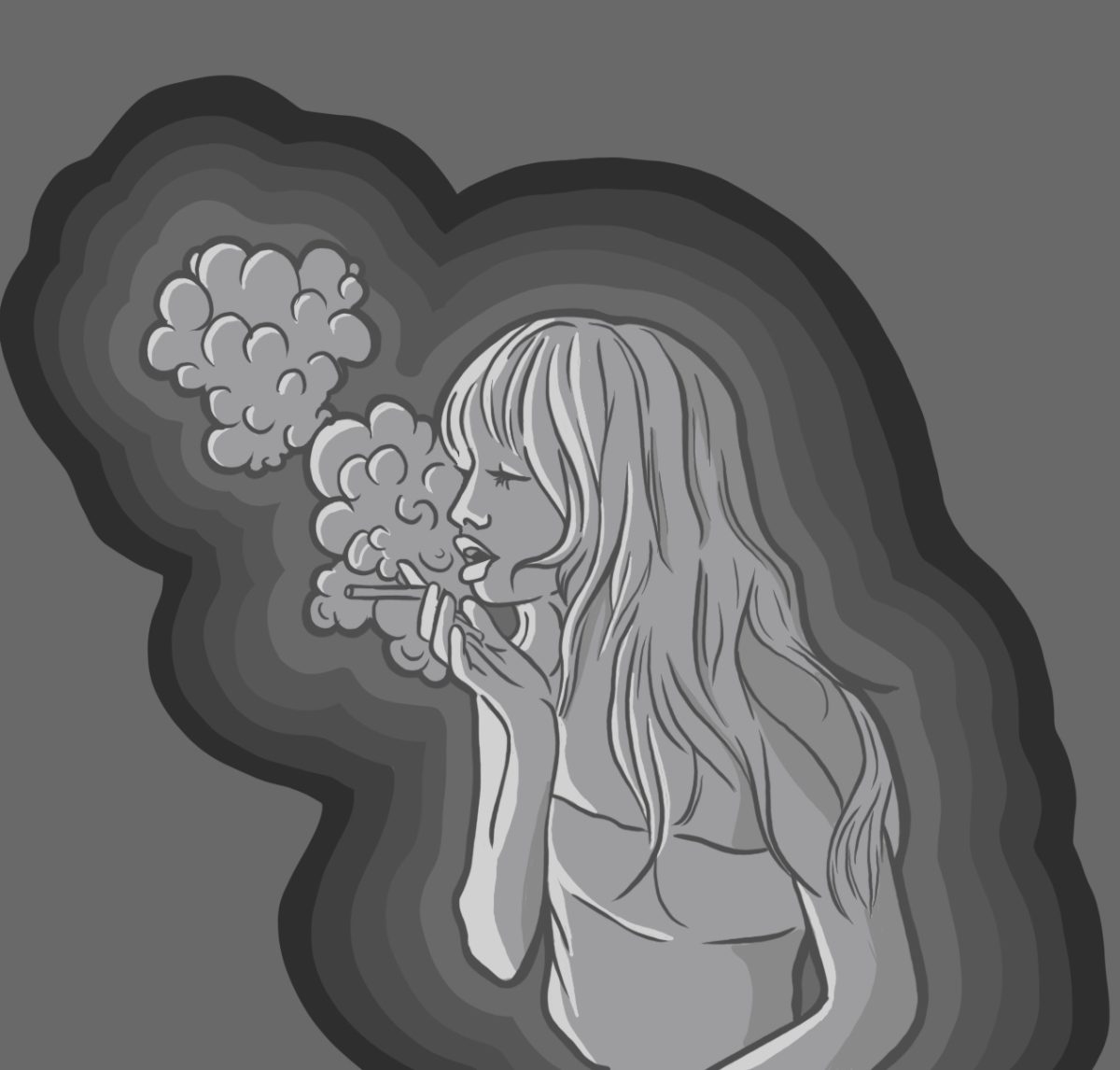Some of the most popular teen shows and movies in the past few years prominently feature glamorized and “cool” protagonists who consistently use cigarettes. Examples includeAnya Taylor-Joy in “The Queen’s Gambit” and Lily Rose-Depp in “The Idol,” two series that feature complicated, struggling lead characters. “The Queen’s Gambit” follows Taylor-Joy’s character Beth Harmon and her journey to becoming an elite chess player while simultaneously battling drug and alcohol addictions. “The Idol” is a show documenting a star’s dramatic downfall and yet Jocelyn, the protagonist, is still depicted as voguish and sexy through her fashion sense and witty remarks, much like Beth Harmon. Another key similarity between the two is their recurrent cigarette use. Cigarettes appeared in every episode of “The Queen’s Gambit” — 220 times in total. Jocelyn smokes three cigarettes within the first five minutes of “The Idol.” As Jocelyn and Beth are both consistently portrayed in a glamorous way, their cigarette use becomes essential to their romanticized images.
“When you look at shows that become exceptionally popular with teenagers, even when the use of nicotine is part of a storyline of destruction, it’s still somehow glamorous,” said Dr. Cara Natterson, a pediatrician and New York Times bestselling author from Los Angeles who writes on puberty and teenage behavior.
This trend, exemplified by Rose-Depp and Taylor-Joy, is no anomaly in recent television, as an increasing number of the films popular among teenagers depict cigarette smoking as a casual, common occurrence. For example, Maeve Wiley, one of the central characters in the popular show “Sex Education,” is a frequent cigarette smoker. She smokes in school, uses constant profanity and steals alcohol. Both the frequency of cigarette use and the glamorization of smoking as a method of social defiance creates a direct correlation between the rebellious behavior shown by characters like Maeve and the public interpretation of those characters as “cool.”
“In the media, rebellion is something that’s seen as cool, and if smoking is rebellion, you know, there’s that,” said UC Berkeley student Maxine, who wished not to use her last name.
Scenes with male heartthrobs, such as Conrad from “The Summer I Turned Pretty” or Billy on “Stranger Things,” have a consistent symbol: a cigarette. Cigarettes are seen by actors and fans as symbols of allure and idealized social rebellion. Jacob Elordi, star of the Netflix movie “The Kissing Booth,” recalled discussing how crucial cigarettes were to the image of his heartthrob character.
“He [Elordi’s character] needs to have cigarettes,” Elordi said. “He’s a bad boy.”
The cigarette’s electronic counterpart, the e-cigarette, more colloquially known as a vape, is not romanticized in the same manner. While younger generations use e-cigarettes more frequently than traditional cigarettes (the 2022 annual Food and Drug Administration tobacco survey found that 3.3% of middle school students admitted to vaping) e-cigarettes do not receive the screen time cigarettes do. This lack of representation may be due in part to their lack of aesthetic appeal compared to cigarettes. They appear frequently on the hit show “Euphoria,” but their depiction on the show is less glamorous and appealing.
“[In ‘Euphoria’] I think [vaping] is portrayed as really gross,” an anonymous Upper Schooler said. “It’s not very attractive.”
When a cigarette is a central accessory to their character, viewers begin to associate a Marlboro or Camel with the unidentifiable quality that makes Beth Harmon, Jocelyn, Maeve, Conrad and Billy so attractive. This association is reflected by an increase in viewers’ cigarette use.
A 2017 Centers for Disease Control and Prevention study found that minors who frequently see smoking on the screen are two to three times more likely to start smoking than those who do not. According to the CDC, 43% of PG-13 rated movies in 2019 showed smoking or other tobacco use. Although vaping is still the most popular usage of tobacco for minors, the public perception of traditional cigarettes has started to shift.
“I think there’s definitely a glamorization of the use of cigarettes … kind of made to look like it’s cool or part of teenage culture,” an anonymous Upper School student said.
Social Scene
Teenagers want to fit in, and they will go to extreme lengths to do so. In high school social scenes, many teens, including those at Marlborough, have observed the rise of cigarette smoking. An anonymous survey about smoking and vaping was sent to the Upper School. Names were withheld from the survey responses in order to protect the privacy of students. According to the 53 responses, 67% of students who completed the survey have noticed an increase in cigarette smoking at social events. For some, smoking cigarettes continues to carry a cool reputation for the current teenage generation despite their parents’ warnings and the obvious risks.
“High schoolers smoke more cigarettes now because it’s cooler, looks better in photos and vaping is thought of as cringe,” one student said. “I have especially noticed a spike in cigarette use within artsier crowds.”
Some students see holding a cigarette as a social cushion for when they’re anxious at parties, giving them access to conversations or crowds they might not feel comfortable joining. Asking for a cigarette, taking smoke breaks or even smoking solo projects an intimidating aesthetic that can be a confidence booster. While at parties, Maxine often waits for a crowd of people who she knows will smoke with her, using a cigarette as a social tool. She believes there is a direct connection between fitting in at parties and having a pack of cigarettes.
“I definitely see it as a prop,” Maxine said. “For me, it’s not about the sensation of it at all. I admit I’m a performative smoker.”
Additionally, many teens are starting to see vaping as an embarrassing, youthful addiction that does not carry the same stylish aesthetic as smoking a cigarette. This phenomenon is especially common among people who vaped when they were younger and have grown up to regret their old habits. Wellesley College sophomore Beverly, who asked not to use her full name, directly associates vaping with middle school students.
“Vaping came into vogue when we were in middle school, so people really associate vapes with the cringiness that is around you when you’re that age,” Beverly said. “That’s why a lot of college students are moving away from vaping because it’s so associated with our youth in a way that’s not favorable.”
Some Marlborough students agree with this claim. While the survey shows the observed rise in cigarette use, there was an overwhelming amount of hate, embarrassment and general disgust towards vaping from the students who responded.
“It’s most embarrassing when people fiend for their vapes and can’t function without them,” Oona ’24 said. “It’s a serious addiction though so in that way it’s really sad, but still, it’s
embarrassing.”
The millennial generation’s frequent vaping changes how teens view cigarettes. Some view cigarette smoking as more mature, and seeing an adult with a flavored vape comes across as childish to many teenagers.
“When you see an adult vaping, you will often hear someone say like, ‘He’s too old to be vaping — get a cigarette’ and anything that a millennial is doing is not something you want to be doing,” one survey respondent said.
According to the FDA, vaping is still more popular in numbers than cigarettes, but with new laws and restrictions limiting access to e-cigarettes, such as the proposition passed in California last year banning the selling of flavored nicotine, the trend in cigarettes is not insignificant.
“People just think it’s cool,” another respondent said. “People want to act like they’re older than they are and smoking cigarettes is a way of achieving that.”
Addiction and Health
Many teenagers are very aware of the health risks of cigarettes,
especially how addictive they are. Although the CDC reported all-time low rates of smoking in April across all age groups, the frequency of cigarette smoking, especially among teenagers, is increasing for the first time in more than two decades, according to reports from the Cancer Council in early June. For many young people, the desire for the cigarette aesthetic has quickly become an addiction. Natterson has taken note of this rise in smoking cigarettes.
“I’m so surprised that smoking is back because teenagers know very well what tar does to the lungs and how addictive nicotine is,” Natterson said. “So they’re making a decision despite having that knowledge, which is really surprising.”
For some, this increase in cigarette smoking can also stem from the belief that it’s a safer option than vaping. According to the FDA, 14.1% of high schoolers vape. Also, the proportion who reported daily vaping increased notably from 34.5% in 2017 to 44.4% in 2020. As vaping rates climb and conflicting reports about its effects spread, some teens are becoming aware of the more uncertain risks of vaping and are turning to what they see as a more researched and therefore “safer” option: cigarettes.
“The reason why I don’t really vape is because I don’t know what I’m putting into my body, and with a cigarette, it’s not great, but … I know that I can smoke a pack a day for 20 years and maybe get lung cancer but also maybe live till I’m 102,” said 18-year-old New School student and smoker Chloe, who asked not to use her full name.
However, Dr. Felicia Fuller, the Director of Health Promotions at the American Lung Association, has a different opinion on the safety of cigarette smoking.
“It’s wrong to think that smoking cigarettes can be — I don’t even want to use the word healthy — a more positive experience than vaping,” Fuller said. “You shouldn’t do either.”
Despite fluctuating trends surrounding the use of certain tobacco products, one consistent pillar of teenage addiction is the significant role of marketing in encouraging the use of these highly addictive products. Lawsuits have stacked up against Juul and other e-cigarette manufacturers for their marketing toward a teen audience. Fuller believes that the e-cigarette industry has been targeting teenagers since the very beginning with its colorful packaging and youthful flavors. She posits that e-cigarette companies hope to loop teens into an addictive cycle, creating lifelong customers. According to the World Health Organization, as trends fluctuate, the nicotine industry quickly adapts to maximize profit from its shifting audiences.
“I really don’t judge kids who smoke at all,” Natterson said. “Nicotine is so addictive, it is not their fault. There are manufacturers who really need to be held accountable for what they’re doing because they’re taking an exceptionally addictive substance and then making it easily accessible to teenagers.”
In 2022, the National Institute on Drug Abuse reported that 11.3% of middle and high school students had smoked cigarettes within the past 30 days before the study was reported. As Chloe suggests, cigarettes are trending and more teens are clinging to them despite the repercussions.
“I can deal with the side effects of having like three cigarettes a day in the next few years,” Chloe said. “I’ll quit eventually, but while I’m young, and honestly, my lungs have the best chance of recuperating, I’ll take that advantage.”









